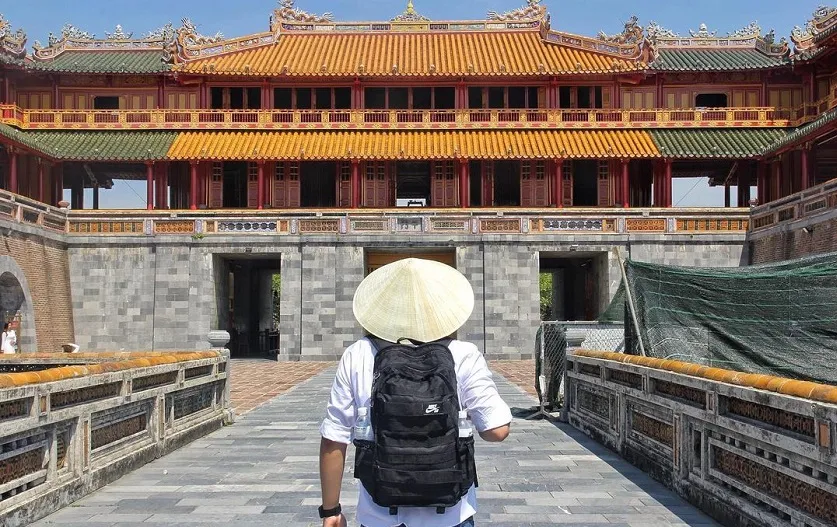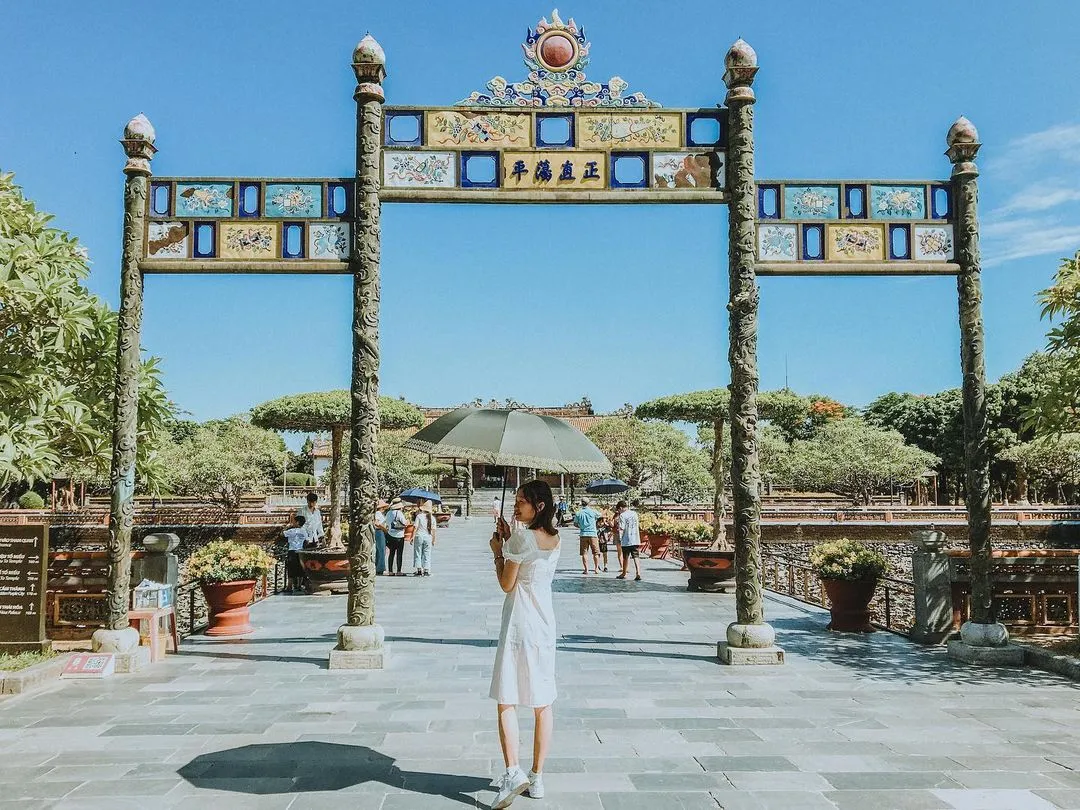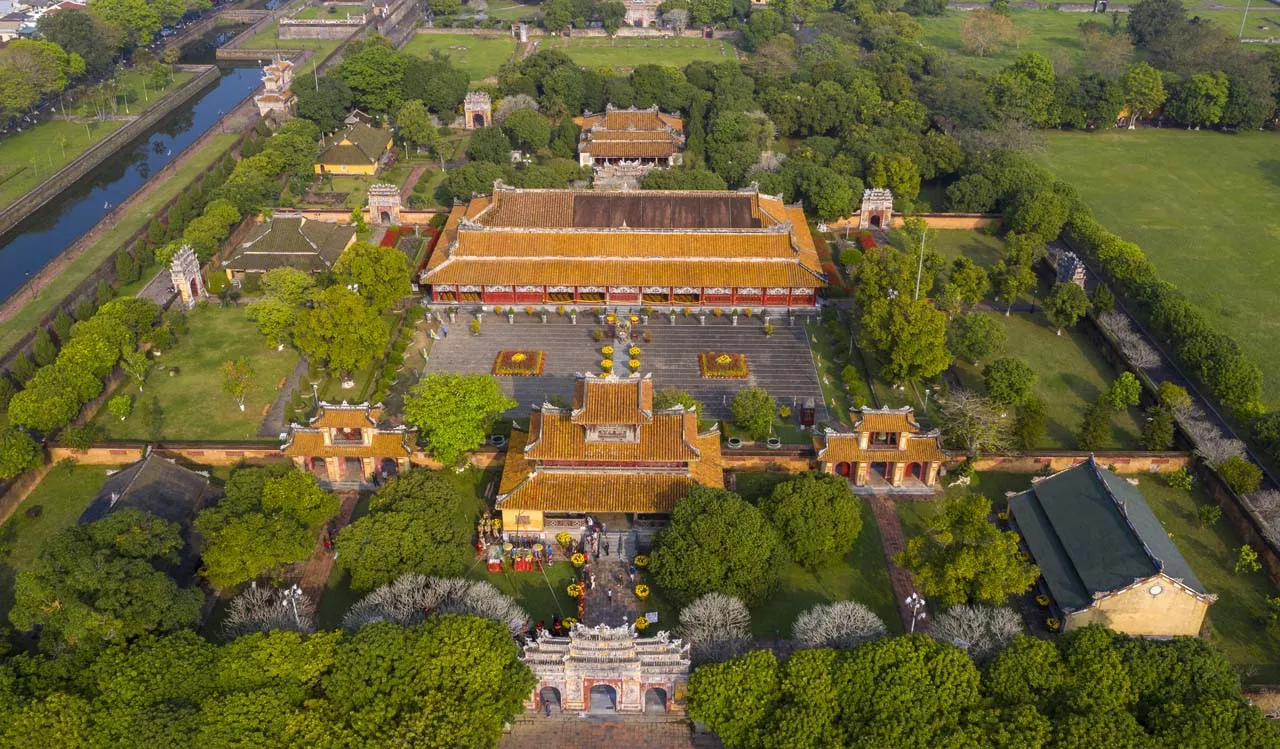The Hue Imperial City, a timeless symbol of Vietnam’s former imperial capital, is not just a historical relic but a living museum of architecture, culture, and the quintessence of the Nguyen Dynasty. Here, every brick and tile is imbued with the sacred spirit of the mountains and rivers, recounting the story of a golden age that has receded into the past but remains deeply etched in the hearts of every Vietnamese person. When visiting Hue, tourists cannot miss the opportunity to immerse themselves in the ancient and solemn space of the Imperial City, to fully appreciate the serene beauty and profound historical value that this place offers.
Hue Imperial City – A Historical Witness Through Time
Hue, the ancient capital with a rich history, served as Vietnam’s capital for 143 years (1802 – 1945) under the Nguyen Dynasty. The Hue Imperial City, a magnificent structure built by Emperor Gia Long and completed under Emperor Minh Mang in 1832, is a powerful testament to the brilliant development of Vietnamese architecture and culture of that era. Spanning an impressive area of 520 hectares, the Hue Imperial City is not only a majestic and square architectural complex but also a repository of invaluable cultural and historical values, having witnessed many upheavals in the nation’s history.
Today, the Hue Imperial City proudly stands as part of the Complex of Hue Monuments, recognized by UNESCO as a World Cultural Heritage Site. This prestigious title further affirms the special status and appeal of the Hue Imperial City on the international tourism map. Each year, millions of visitors from around the world flock here to admire its ancient beauty, explore historical mysteries, and enjoy the unique cultural space that the Hue Imperial City offers. Alongside other famous destinations in Hue such as Thien Mu Pagoda and Khai Dinh Tomb, the Hue Imperial City has become an indispensable stop in the journey to explore the ancient capital, captivating visitors with its timeless beauty and compelling historical narratives.

Explore Hue Imperial City, a World Heritage Site and a captivating destination for both domestic and international tourists.
Unraveling the Allure of Hue Imperial City: Unique Architecture and Prominent Attractions
The Hue Imperial City impresses not only with its grand scale but also with its unique architecture, deeply imbued with the cultural and historical imprints of the Nguyen Dynasty. With an almost perfectly square layout, the Hue Imperial City was built according to feng shui principles, harmonizing nature and humanity. Legend has it that the Citadel was designed to face South, symbolizing the rule over the world, expressing the aspiration for a powerful and prosperous nation. Within the Imperial City, the Royal Citadel and the Forbidden Purple City also follow this direction, creating unity and harmony in the overall architecture.
The most distinctive highlight of the Hue Imperial City is its system of ancient architectural works, each carrying its own beauty and meaning, vividly portraying the ancient court life.
Ngo Mon Gate – The Majestic Main Gate of the Royal Citadel
Ngo Mon Gate, the main southern gate of the Royal Citadel, is one of the most iconic and famous architectural works of the Hue Imperial City. Ngo Mon Gate is not just an entrance but also a symbol of the power and solemnity of the Nguyen Dynasty court. The Five-Phoenix Pavilion, located atop Ngo Mon Gate, with its unique architecture of a 5-tiered overlapping roof, is a distinctive highlight that attracts every gaze. The solid stone walls and the intricate carvings on the roof tiles all blend together to create a space that is both airy and serene, and magnificent and imposing, leaving visitors in awe of its architectural masterpiece.

Admire Ngo Mon Gate, the majestic main gate of Hue Royal Citadel, an ancient architectural masterpiece.
Royal Citadel – The Power Center of the Nguyen Dynasty
The Royal Citadel, the second enclosure of the Hue Imperial City, is home to over 100 ancient architectural works, deeply imbued with the historical and cultural imprints of the Nguyen Dynasty. It was not only the residence of the king and royal family but also the administrative center, where important court activities took place. Thai Hoa Palace, one of the most prominent structures in the Royal Citadel, is considered a symbol of the Hue Imperial City and served as the venue for important ceremonies of the Nguyen Dynasty. In addition, the Royal Citadel also houses many other distinctive architectural works such as Thai Mieu Temple, The Mieu Temple, Hung Mieu Temple, and Dien Tho Palace, each carrying its own historical narrative and cultural value.
Thai Hoa Palace – An Architectural Symbol of Hue Imperial City
Thai Hoa Palace, located within the Royal Citadel, is a unique and exquisite architectural work, showcasing the pinnacle of Hue’s imperial court architecture. Thai Hoa Palace stands out with its vibrant and luxurious colors, using two main tones of red and gold, symbolizing the power and wealth of the royal family. Outside Thai Hoa Palace is a spacious courtyard, adorned with fish ponds and meticulously trimmed precious ornamental plants, creating a harmonious and peaceful space that enhances the magnificent beauty of this architectural masterpiece.

Marvel at Thai Hoa Palace, a unique and magnificent architectural symbol of Hue Royal Citadel.
When visiting the Hue Imperial City, tourists not only get to admire the beautiful architectural works and capture memorable moments but also have the opportunity to learn more about the history, culture, and customs of the Nguyen Dynasty, as well as the unique features of Hue culture.
Journey to Hue Imperial City: Easy and Convenient
From the city center of Hue, getting to the Hue Imperial City is extremely easy and convenient. Tourists can choose from various means of transportation to visit this historical site.
Traveling by motorbike/car:
- Motorbike: From the city center, tourists can follow Tran Hung Dao Street, cross Phu Xuan Bridge, then turn onto Le Duan Street and go straight to the Hue Imperial City. This route is only about 3km and takes about 10-15 minutes by motorbike.
- Car: Similar to motorbikes, tourists follow Tran Hung Dao Street, cross Phu Xuan Bridge, turn onto Le Duan Street, and go straight to the Hue Imperial City. Travel time by car is also similar to motorbike, about 10-15 minutes.
Traveling by taxi/ride-hailing service:
Taxis and ride-hailing services are popular and convenient means of transportation in Hue. Tourists can easily book a car to get to the Hue Imperial City quickly and comfortably.
Traveling by cyclo/bicycle:
If you want to experience the ancient capital space in a leisurely and romantic way, you can choose a cyclo or bicycle. Cyclos are a traditional and distinctive means of transport in Hue, offering tourists interesting experiences while strolling around the Imperial City. Bicycles are also a great option, allowing tourists to explore the Imperial City and surrounding areas freely and proactively.
Hue Imperial City Travel Tips: Preparing for a Complete Trip
To have a truly complete and meaningful visit to the Hue Imperial City, tourists should note some of the following tips:
Entrance Fees:
To visit the Hue Imperial City, especially the Royal Citadel area inside, tourists need to purchase an entrance ticket. Current ticket prices (year 2023) are:
- Adults: VND 150,000/person/entry
- Children (6-12 years old): VND 30,000/child/entry
Tourists should prepare cash to buy tickets at the entrance.
Appropriate Attire:
The Hue Imperial City is a vast historical site, and tourists will have to walk quite a lot to visit all the architectural works. Therefore, you should choose comfortable, neat, and easy-to-move clothing such as jeans, joggers, t-shirts, and shirts. Sneakers or flat shoes are ideal choices for easy movement and to avoid foot pain.
In addition, the Hue Imperial City is a place of solemnity and history, and tourists should avoid wearing revealing or offensive clothing such as tank tops or overly short shorts. Priority should be given to polite and discreet clothing to show respect for the historical and cultural site.

Choose polite and comfortable attire when visiting Hue Imperial City for the best experience.
Ideal Time to Visit:
Hue weather has two distinct seasons: the rainy season (September – December) and the dry season (January – August). The dry season is the best time to travel to Hue and visit the Imperial City. However, in the summer (May – August), Hue weather is quite hot, so tourists should prepare hats, sunscreen, and drink enough water to avoid heatstroke.
Early morning or late afternoon is the best time to visit the Hue Imperial City, when the weather is cool and the sunlight is gentle, helping visitors have comfortable experiences and capture the most beautiful photos.
Other Notes:
- You should bring a map or a travel map application for easy navigation and exploration of the Hue Imperial City.
- Prepare drinking water and snacks to replenish energy during the visit.
- Maintain general hygiene and do not litter indiscriminately in the historical site.
- Respect the regulations and instructions of the site management board.
- If you have time, tourists should combine visiting the Hue Imperial City with other famous destinations in Hue such as the tombs of the Nguyen emperors, Thien Mu Pagoda, Perfume River, and Ngu Binh Mountain to have a complete journey to explore the ancient capital.
Conclusion
Hue Imperial City, the precious gem of the ancient capital, is a must-visit destination for those who love exploring Vietnamese history, culture, and architecture. With its ancient and solemn beauty and profound historical and cultural values, the Hue Imperial City promises to bring visitors memorable experiences and unforgettable emotions in their journey to explore the ancient capital. Come and feel the timeless beauty of the Hue Imperial City, to understand more about a heroic historical period of the nation and to further love Vietnam’s country and people.